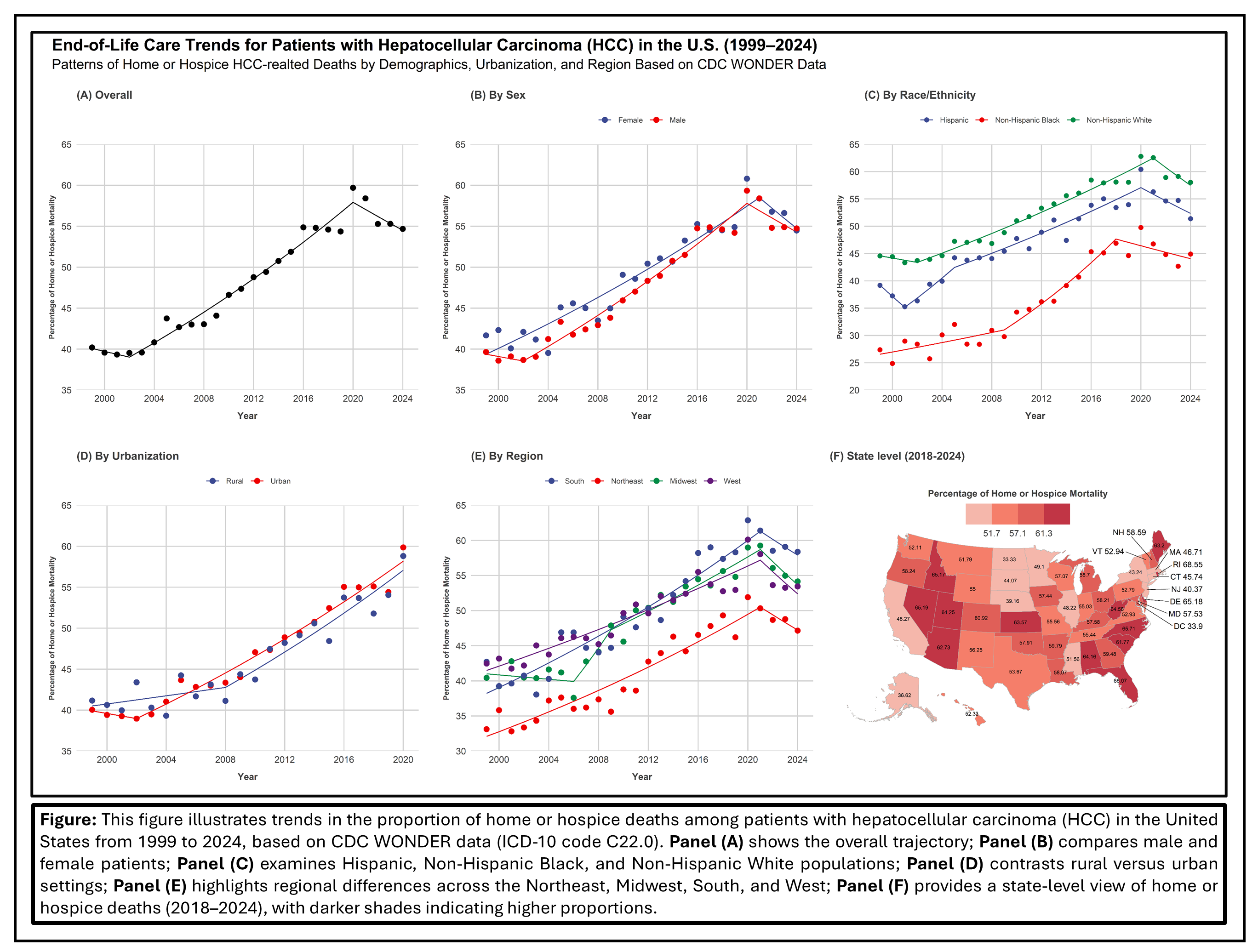Sunday Poster Session
Category: Liver
P1613 - Evolving End-of-Life Care Patterns for Hepatocellular Carcinoma in the United States: A 25-Year Analysis of Home and Hospice Deaths by Demographic, Regional, and Urbanization Factors
Sunday, October 26, 2025
3:30 PM - 7:00 PM PDT
Location: Exhibit Hall

Mohamed B. Elnaggar, MD
Hartford Healthcare
Hartford, CT
Presenting Author(s)
Mohamed A. B. Elnaggar, MD1, Ibrahim Hassan, MBBCh2, Ayah Obeid, MD3, Hatem Eltaly, MD4, Mohamed Abd El Aziz, MD5, Raffi Karagozian, MD6
1Hartford Healthcare, Hartford, CT; 2Faculty of Medicine, Suez Canal University, Ismailia, Al Isma'iliyah, Egypt; 3St. Luke's University Health Network, Bethlehem, PA; 4Cleveland Clinic Foundation, Cleveland, OH; 5Deaconess health system, Henderson, KY; 6Tufts University School of Medicine, Boston, MA
Introduction: Hepatocellular carcinoma (HCC) remains one of the leading causes of cancer-related mortality worldwide and in the United States. Recently, there has been a growing emphasis on end-of-life care delivered in home or hospice settings, yet detailed contemporary insights into how these patterns differ by sex, race/ethnicity, region, and urbanization remain sparse. our study focus on the trends in the proportion of HCC decedents receiving home or hospice care over 25 years using nationwide surveillance data.
Methods: Data for HCC-related mortality were obtained from the Centers for Disease Control and Prevention’s Wide-ranging Online Data for Epidemiologic Research (CDC WONDER) database by ICD-10 code (C22.0), covering the years from 1999 to 2024. The analysis focused on the proportion of home or hospice deaths relative to the total number of HCC-related deaths. Overall population trends stratified by race/ethnicity, sex, census region, and urbanization. Trend analysis was conducted using Joinpoint 5.30 to identify significant changes in the temporal patterns.
Results: The overall patients with HCC who died at home or in hospice increased steadily over the study period, rising from approximately 40.19% in 1999 to 54.67% in the most recent year, with an overall aggregate proportion of around 47.6%. Among the different racial and ethnic groups, non-Hispanic white decedents showed a notable increase from 44.57% to 58.04%, non-Hispanic black decedents increased from 27.38% to 44.91%, and Hispanic decedents increased from 39.17% to 51.38%.Both female and male patients experienced rising trends in home or hospice deaths, with females increasing from 41.67% to 54.48% and males from 39.64% to 54.73%.Regional variations were evident, with the South consistently reporting the highest proportions of home or hospice deaths, starting at 42.71% in 1999 and reaching 58.38% in the latest data, while the Northeast exhibited comparatively lower rates. A similar upward trend between 1999 and 2020 was observed in rural and urban areas, with rural settings increasing from 41.16% to 58.81% and urban settings from 40.04% to 59.86%.
Discussion: Findings show over the past 25 years, more HCC patients in the U.S. are receiving End of life care at home or in Hospice however significant disparities persist across demographics, regions, Urbanization levels. Targeted policies and improved access are needed to Ensure equitable and high quality care for all.

Figure: End of life care trends for patients with HCC in the U.S. (1999-2024)
Disclosures:
Mohamed A. Elnaggar indicated no relevant financial relationships.
Ibrahim Hassan indicated no relevant financial relationships.
Ayah Obeid indicated no relevant financial relationships.
Hatem Eltaly indicated no relevant financial relationships.
Mohamed Abd El Aziz indicated no relevant financial relationships.
Raffi Karagozian indicated no relevant financial relationships.
Mohamed A. B. Elnaggar, MD1, Ibrahim Hassan, MBBCh2, Ayah Obeid, MD3, Hatem Eltaly, MD4, Mohamed Abd El Aziz, MD5, Raffi Karagozian, MD6. P1613 - Evolving End-of-Life Care Patterns for Hepatocellular Carcinoma in the United States: A 25-Year Analysis of Home and Hospice Deaths by Demographic, Regional, and Urbanization Factors, ACG 2025 Annual Scientific Meeting Abstracts. Phoenix, AZ: American College of Gastroenterology.
1Hartford Healthcare, Hartford, CT; 2Faculty of Medicine, Suez Canal University, Ismailia, Al Isma'iliyah, Egypt; 3St. Luke's University Health Network, Bethlehem, PA; 4Cleveland Clinic Foundation, Cleveland, OH; 5Deaconess health system, Henderson, KY; 6Tufts University School of Medicine, Boston, MA
Introduction: Hepatocellular carcinoma (HCC) remains one of the leading causes of cancer-related mortality worldwide and in the United States. Recently, there has been a growing emphasis on end-of-life care delivered in home or hospice settings, yet detailed contemporary insights into how these patterns differ by sex, race/ethnicity, region, and urbanization remain sparse. our study focus on the trends in the proportion of HCC decedents receiving home or hospice care over 25 years using nationwide surveillance data.
Methods: Data for HCC-related mortality were obtained from the Centers for Disease Control and Prevention’s Wide-ranging Online Data for Epidemiologic Research (CDC WONDER) database by ICD-10 code (C22.0), covering the years from 1999 to 2024. The analysis focused on the proportion of home or hospice deaths relative to the total number of HCC-related deaths. Overall population trends stratified by race/ethnicity, sex, census region, and urbanization. Trend analysis was conducted using Joinpoint 5.30 to identify significant changes in the temporal patterns.
Results: The overall patients with HCC who died at home or in hospice increased steadily over the study period, rising from approximately 40.19% in 1999 to 54.67% in the most recent year, with an overall aggregate proportion of around 47.6%. Among the different racial and ethnic groups, non-Hispanic white decedents showed a notable increase from 44.57% to 58.04%, non-Hispanic black decedents increased from 27.38% to 44.91%, and Hispanic decedents increased from 39.17% to 51.38%.Both female and male patients experienced rising trends in home or hospice deaths, with females increasing from 41.67% to 54.48% and males from 39.64% to 54.73%.Regional variations were evident, with the South consistently reporting the highest proportions of home or hospice deaths, starting at 42.71% in 1999 and reaching 58.38% in the latest data, while the Northeast exhibited comparatively lower rates. A similar upward trend between 1999 and 2020 was observed in rural and urban areas, with rural settings increasing from 41.16% to 58.81% and urban settings from 40.04% to 59.86%.
Discussion: Findings show over the past 25 years, more HCC patients in the U.S. are receiving End of life care at home or in Hospice however significant disparities persist across demographics, regions, Urbanization levels. Targeted policies and improved access are needed to Ensure equitable and high quality care for all.

Figure: End of life care trends for patients with HCC in the U.S. (1999-2024)
Disclosures:
Mohamed A. Elnaggar indicated no relevant financial relationships.
Ibrahim Hassan indicated no relevant financial relationships.
Ayah Obeid indicated no relevant financial relationships.
Hatem Eltaly indicated no relevant financial relationships.
Mohamed Abd El Aziz indicated no relevant financial relationships.
Raffi Karagozian indicated no relevant financial relationships.
Mohamed A. B. Elnaggar, MD1, Ibrahim Hassan, MBBCh2, Ayah Obeid, MD3, Hatem Eltaly, MD4, Mohamed Abd El Aziz, MD5, Raffi Karagozian, MD6. P1613 - Evolving End-of-Life Care Patterns for Hepatocellular Carcinoma in the United States: A 25-Year Analysis of Home and Hospice Deaths by Demographic, Regional, and Urbanization Factors, ACG 2025 Annual Scientific Meeting Abstracts. Phoenix, AZ: American College of Gastroenterology.
